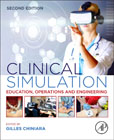
Clinical Simulation, Second Edition, offers readers a restructured, comprehensive, and updated approach to learn about simulation practices and techniques in a clinical setting. Featuring new and revised chapters from the industry's top researchers and educators, this second edition gives readers the most updated data through modern pedagogy. Clinical Simulation, Second Edition has been restructured to highlight five major components of simulation education. The book first examines simulation scenarios as tools, then student learning, faculty teaching, necessary subject matter, and finally the learning environment. With clear and efficient organization throughout the book, Clinical Simulation, Second Edition, is the ideal text for students and professionals to receive a concise introduction to this subject area. Edited by a leading educator, consultant, and practitioner in the clinical simulation fieldRedesigned structure using the five components of simulation pedagogyOver 30 new chapters to feature the most up-to-date industry information and practices INDICE: 1. The history of simulation: how did we get here? 2. The many faces of simulation 3. Standardized patients 4. Virtual patients and serious games 5. Simulation as a social event 6. Simulation from an industry perspective 7. A systematic approach to scenario design 8. Theoretical Underpinnings of Scenario Design 9. A Pragmatic Approach to Scenario Scripting 10. Designing a scenario as a simulated clinical experience: the TuPASS scenario script 11. From fidelity to authenticity 12. Realism and the art of simulation 13. Cognitive Load Theory in simulation 14. Adapting Learning in a Simulated Environment 15. Simulation-based Education and the Challenge of Transfer 16. Educational theory for simulation 17. Learning through play 18. Adult education methods and processes 19. Motivational dynamics in simulation training 20. Becoming a Simulation Instructor and Learning to Facilitate: The Instructor and Facilitation Training (InFacT) Course 21. Briefing and Prebriefing 22. Debriefing for the transfer of learning 23. Debriefing techniques 24. Adult Learning: Practical Hands-on Methods for Teaching a Hands-on Subject 25. Creating Effective Learning Environments: The Educator's Perspective 26. Curriculum Design for Simulation (merged chapter - title to follow) 27. Complementing Simulation with Other Learning Modalities 28. When Simulation Should and Should Not Be in the Curriculum 29. Integration of Simulation with Existing Clinical Educational Programs 30. Theory and Practice of Developing an Effective Simulation-based Clinical Curriculum 31. Planning and Assessing Clinical Simulation using Task Analysis: A Suggested Approach and Framework for Trainers, Researchers, and Developers. 32. A National Simulation Program: Germany 33. Educational aspects of in situ or situated simulation 34. Simuation for procedural tasks 35. Simulation for Pediatrics and Neonatal Care 36. Simulation for Critical Care 37. Simulation for Pharmacy 38. Crisis Management and Non-Technical Skills: From the Individual to the Organization 39. Simulation for Learning Clinical Reasoning 40. Fundamentals of Educational Research Using Clinical Simulation 41. Simulation for Assessment 42. Simulation and High-stakes Testing 43. Evaluating Simulation Programs 44. Simulation Facility Design 101: The Basics 45. Assessing and Planning for a New Simulation Center 46. Creation of Structure-Function Relationships in the Design of a Simulation Center 47. Creative Procurement for Your Simulation Program 48. Simulation on a Low Budget 49. The One-Room Schoolhouse for Simulation 50. The All-in-One-Room Schoolhouse 51. The Dedicated Clinical Simulation Suite 52. Simulation in Remote Areas 53. Choosing Patient Simulators and Equipment 54. Physiologic Modeling for Simulators: Get real 55. Infrastructures in the Service of Simulation 56. Professional Stage Craft: How to Create Simulated Clinical Environments Out of Smoke and Mirrors 57. Roles and Functions in a Simulation Center 58. The Simulation Operations Specialist 59. Simulation Center Governance and Management 60. Overcoming Operational Challenges: An Administrator's Perspective 61. Funding for Simulation 62. An Innovative Way to Think about Simulation Laboratory Core Administrative Functions: Comparing Managing a Simulation Laboratory to a Restaurant 63. Accrediting Simulation Centers 64. The unique opportunities in the world of obstetric simulation 65. Simulation for workplace adaptation and organizational change 66. Train the Trainers: Creating Simulation Educators
- ISBN: 978-0-12-815657-5
- Editorial: Academic Press
- Encuadernacion: Cartoné
- Páginas: 920
- Fecha Publicación: 01/08/2019
- Nº Volúmenes: 1
- Idioma: Inglés
